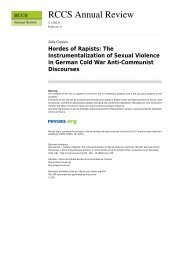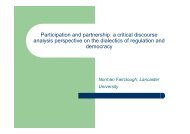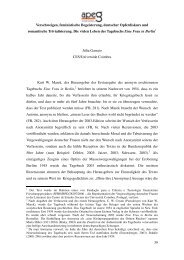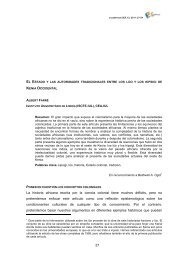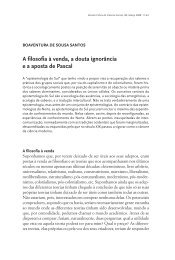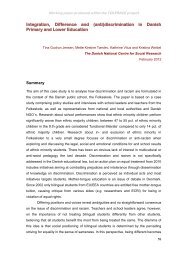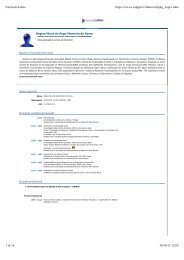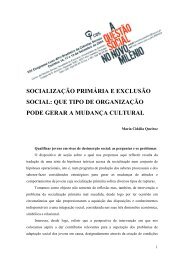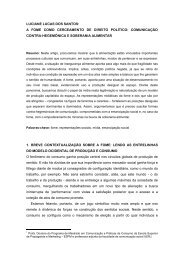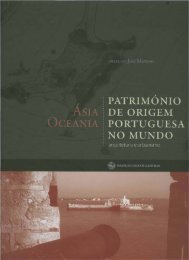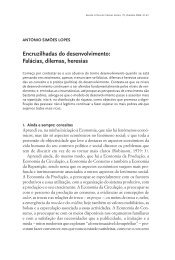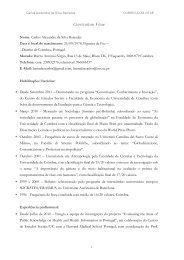Analysis of Integration Policies and Public State-Endorsed ...
Analysis of Integration Policies and Public State-Endorsed ...
Analysis of Integration Policies and Public State-Endorsed ...
You also want an ePaper? Increase the reach of your titles
YUMPU automatically turns print PDFs into web optimized ePapers that Google loves.
Working paper produced within the TOLERACE project<br />
law to advise the parliament, the government, municipalities, private organizations <strong>and</strong><br />
other community institutions in issues related to discrimination <strong>and</strong> ethnic equality.<br />
However, along with a number <strong>of</strong> other boards <strong>and</strong> councils it was dissolved in 2002.<br />
The same year the Danish Institute for Human Rights replaced the Danish Centre for<br />
Human Rights, <strong>and</strong> in 2003 a Complaints Committee for Ethnic Equal Treatment was<br />
established at the institute. In 2009, the Committee (as well as the Gender Equality<br />
Board) was replaced by the Board <strong>of</strong> Equal Treatment. Today the main governmental<br />
institutions involved in securing <strong>and</strong> trying the national laws against discrimination <strong>and</strong><br />
racism are the Danish Institute for Human Rights <strong>and</strong> the Board for Equal Treatment.<br />
2. Main features <strong>of</strong> the Danish integration Policy<br />
Two central acts constitute the main body <strong>of</strong> Danish legislation on immigration <strong>and</strong><br />
integration: the Aliens (consolidation) Act (Udlændingeloven) <strong>and</strong> the <strong>Integration</strong> Act<br />
(<strong>Integration</strong>sloven). The Aliens act addresses foreigners‘ legal status in Denmark<br />
concerning for example entry <strong>and</strong> residence permits (temporary <strong>and</strong> permanent)<br />
whereas the <strong>Integration</strong> Act concerns the actual processes <strong>of</strong> integration. Until August<br />
2010, the <strong>Integration</strong> Act addressed only refugees <strong>and</strong> family reunification <strong>of</strong> refugees<br />
<strong>and</strong> immigrants, but a recent law reform has exp<strong>and</strong>ed the target group to include for<br />
example labour immigrants <strong>and</strong> their families. When speaking in general about Danish<br />
immigration <strong>and</strong> integration policy other laws are referred to as well; e.g. Act on Danish<br />
Nationality, Act on Danish Courses for Adult Aliens, <strong>and</strong> the Municipal <strong>and</strong> Regional<br />
Election Act.<br />
In Denmark, the rules for citizenship follow the principles <strong>of</strong> jus sanguinis; the<br />
citizenship <strong>of</strong> children following that <strong>of</strong> the parents. Dual citizenship is not accepted<br />
in Denmark. Since 2002 several restrictions concerning immigration, residence <strong>and</strong><br />
citizenship has been introduced; major restrictions include for example the abolition <strong>of</strong><br />
the rule concerning de facto refugees in 2002, 34 <strong>and</strong> the issuing <strong>of</strong> the so-called ‘24-<br />
year rule‘ in 2002, raising the age from 18 to 24 for both parties involved in marriage<br />
reunification. The conditions to gain permanent residence permit <strong>and</strong> citizenship has<br />
also been restricted during the last years; e.g. by introducing the ‗<strong>Integration</strong> Contract‘<br />
in 2006, <strong>and</strong> the ‗<strong>Integration</strong> Exam‘ in 2007.<br />
34 De facto refugees are refugees who were granted asylum without being included in the Geneva<br />
Convention <strong>of</strong> 1951. After 2002 only refugees who have a right to protection according to international<br />
conventions are granted asylum.<br />
55



